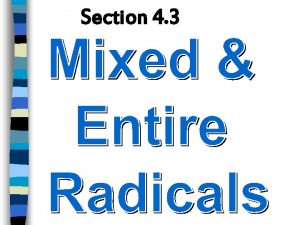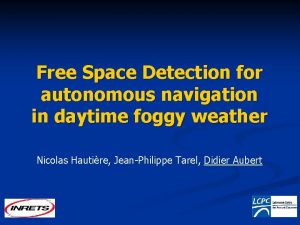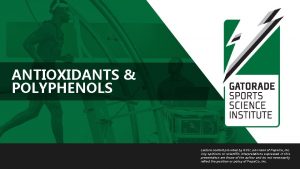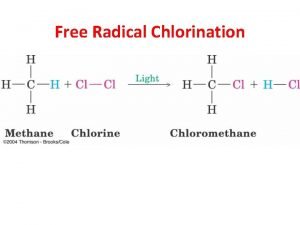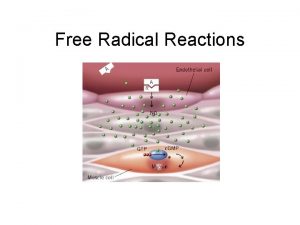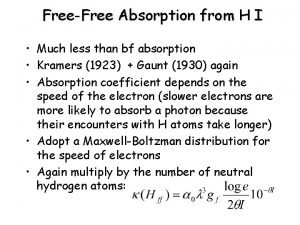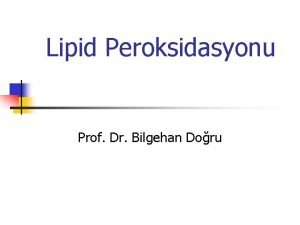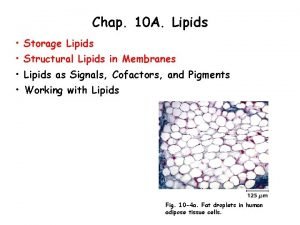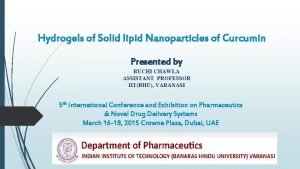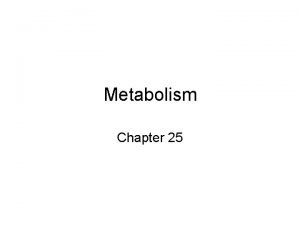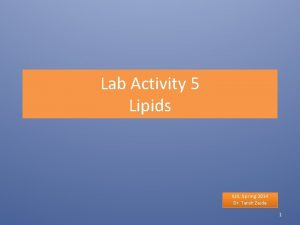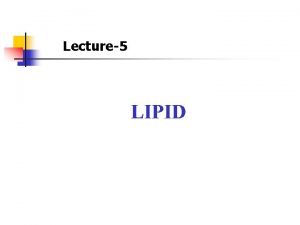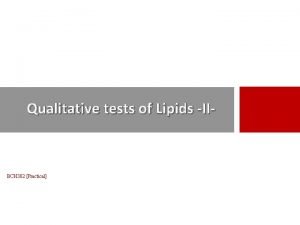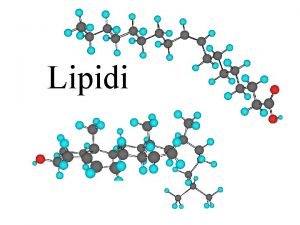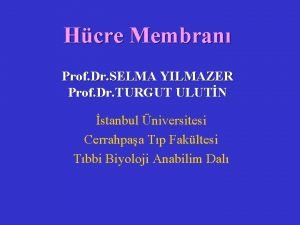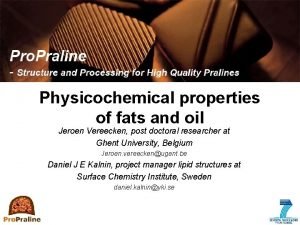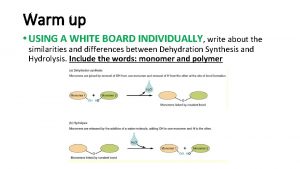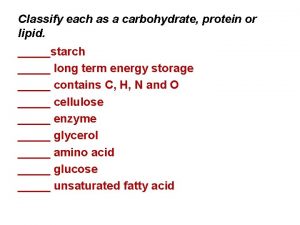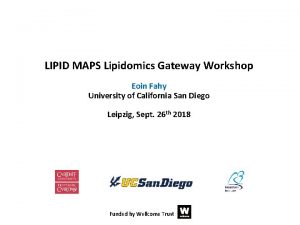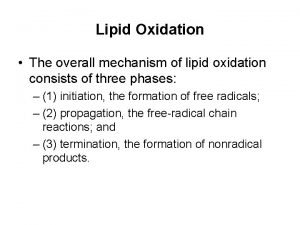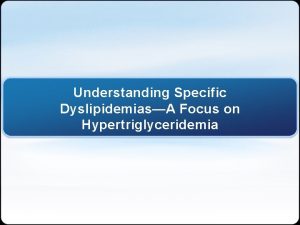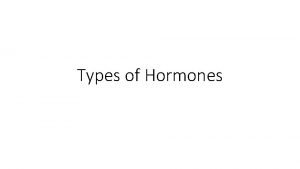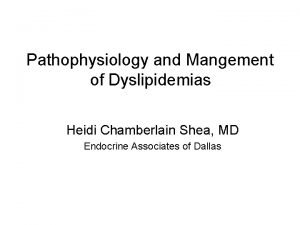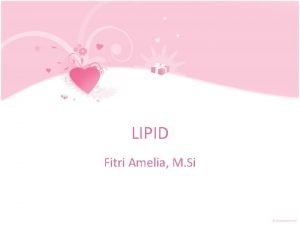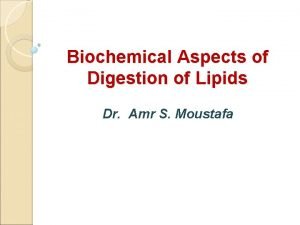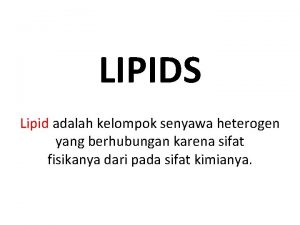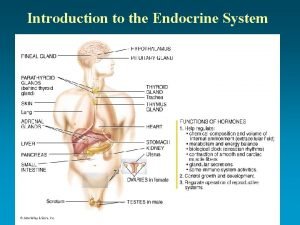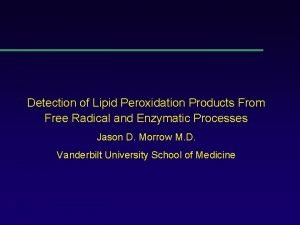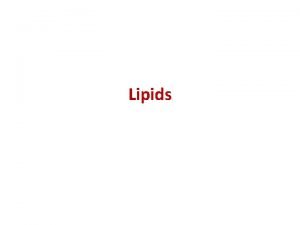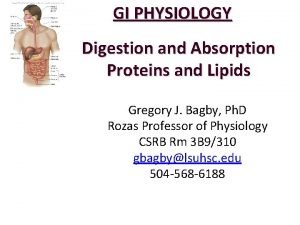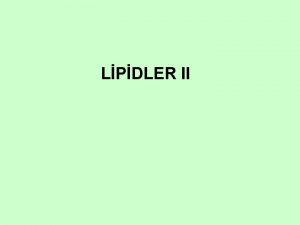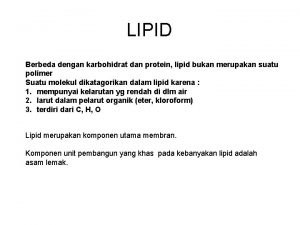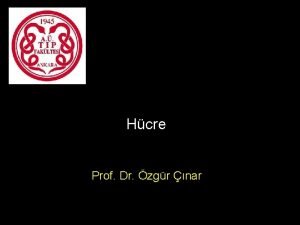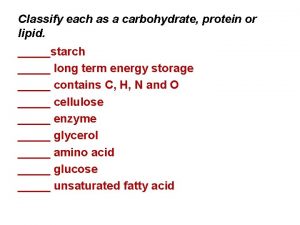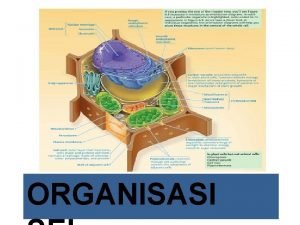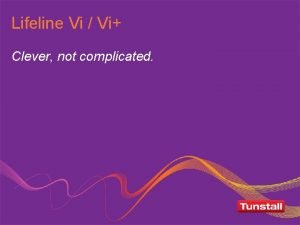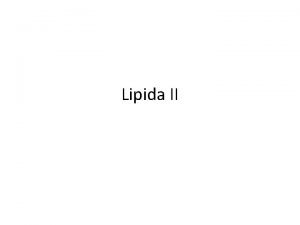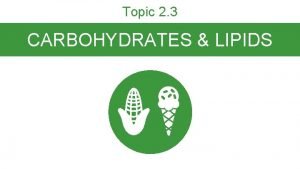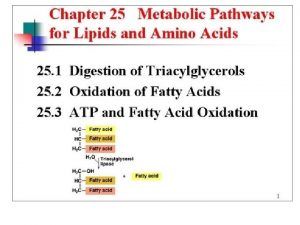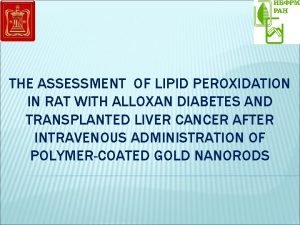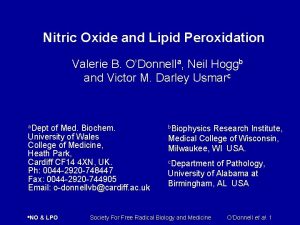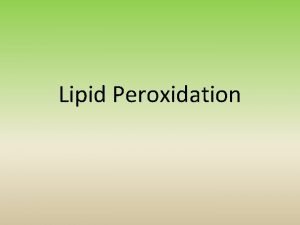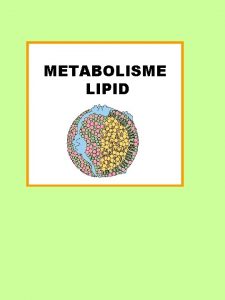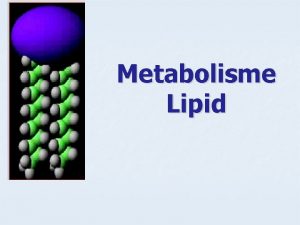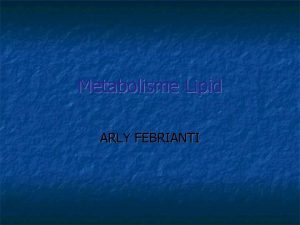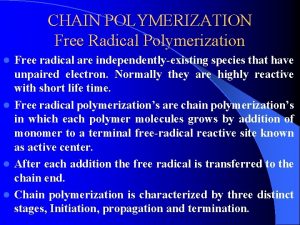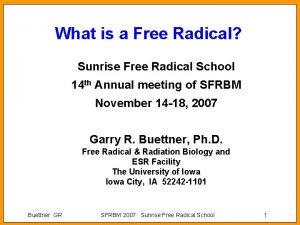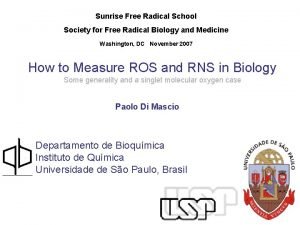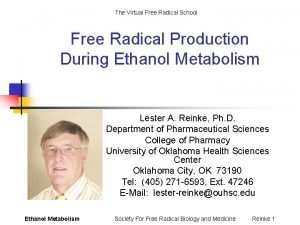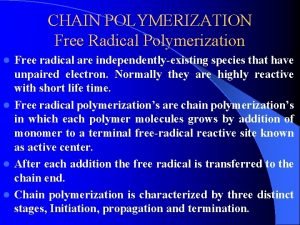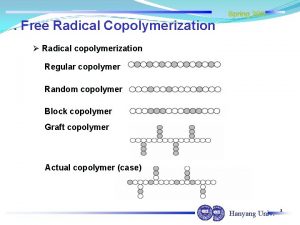Detection of Lipid Peroxidation Products From Free Radical


































![Analysis of F 2 -Isoprostanes in Human Plasma [2 H 4]15 -F 2 t-Iso. Analysis of F 2 -Isoprostanes in Human Plasma [2 H 4]15 -F 2 t-Iso.](https://slidetodoc.com/presentation_image/7209d03e57e4ac141e878ca07420c052/image-35.jpg)


















- Slides: 53

Detection of Lipid Peroxidation Products From Free Radical and Enzymatic Processes Jason D. Morrow M. D. Vanderbilt University School of Medicine

Question? u Which one of the following is the most accurate assessment of systemic prostaglandin production in humans? Ÿ Urinary parent prostaglandins Ÿ Plasma parent prostaglandins Ÿ Major circulating eicosanoid metabolites Ÿ Major urinary eicosanoid metabolites Ÿ Serum parent prostaglandins

Question? u In which of the following diseases has lipid peroxidation definitively been shown to be involved in disease pathogenesis? Ÿ Ÿ Ÿ Atherosclerosis Scleroderma Pulmonary hypertension Stroke All of the above None of the above

Question? u All of the following are potential disadvantages of measuring isoprostanes as an index of oxidant stress except: Ÿ They can be formed ex vivo. Ÿ They are unstable and rapidly degrade ex vivo. Ÿ Accurate assay methods are complex and expensive. Ÿ They represent only one of a myriad of end products of lipid peroxidation. Ÿ Their quantification in a particular body fluid may not be an index of systemic (total body) oxidant stress. Ÿ Immunoassay kits to measure isoprostanes are of questionable accuracy.

Goals of Lecture u Critical appraisal of methods to detect and quantify enzymatic and non-enzymatic products of lipid peroxidation in vitro and in vivo. Ÿ Theoretical considerations regarding quantification of products. Ÿ Assays currently available to measure enzymatic and non -enzymatic lipid peroxidation. » Eicosanoids and related compounds. » Non-enzymatically-derived lipid peroxidation products.

Background u Enzymatic and non-enzymatic products of lipid peroxidation are implicated in many diseases. Ÿ Ischemia-reperfusion injury Ÿ Cancer Ÿ Inflammation Ÿ Aging u Underlying mechanisms and factors responsible for the generation of these products, however, are poorly understood. u Until the past decade, reliable methods of assessment have not been available.

Cellular Sources of Free Radicals and Lipid Peroxidation Products

Lipid Peroxidation

The Ideal Assay of Lipid Peroxidation Products u Assay is an accurate, specific, and sensitive index of lipid peroxidation. u Compounds to be quantified are stable. u Assay applicable to in vitro and in vivo studies. u Assay easy to perform with high throughput. u Assay economical.

Assays of Lipid Peroxidation Products u No assay is ideal. u Most assays are more accurate when quantifying lipid peroxidation products in vitro than in vivo. u Little data exist comparing various methods in vivo. u Only a few assays accurately provide an integrated assessment of lipid peroxidation in an animal or human as a whole.

Pathways of Enzymatic Eicosanoid Generation u Eicosanoid-umbrella term for oxygenated derivatives of arachidonic acid (C 20: 4, w-6). Ÿ Other fatty acids can yield similar products. Ÿ Primary enzymatic pathways-cyclooxygenase (COX), lipoxygenase (LOX), cytochrome P 450.

Pathway of Prostaglandin Formation

Lipoxygenase Pathways

Methods to Detect and Quantify Enzymatically. Generated Lipid Peroxidation Products u High pressure liquid chromatography. u Immunoassay methods. u Mass spectrometry. Ÿ Gas chromatography/mass spectrometry. Ÿ Liquid chromatography/mass spectrometry.

High Pressure Liquid Chromatography u Relatively straightforward to perform. u Equipment available in many laboratories. Ÿ Detection methods-UV absorbance, radioactivity. u Lack of sensitivity and specificity for most eicosanoids. Ÿ Detection limits in the microgram range for many eicosanoids. Ÿ Quantification often inaccurate. Ÿ Compound identification requires additional methods for confirmation.

Immunoassay Methods To Quantify Eicosanoid Metabolites (EIAs and RIAs) u Advantages. Ÿ Commercially available. Ÿ Easy to perform with high throughput. Ÿ Generally sensitive. u Disadvantages. Ÿ Lack of specificity. » Significant cross-reactivity with other lipids.

Quantification of Eicosanoids by Gas Chromatography/Mass Spectrometry u Advantages. Ÿ Highly precise and accurate using stable isotope dilution techniques. Ÿ High sensitivity. u Disadvantages. Ÿ Extensive sample cleanup and derivatization necessary. Ÿ Equipment expensive and not routinely available.

Derivatization of PGE 2 for Analysis by GC/MS

Liquid Chromatography/Mass Spectrometry u Has revolutionized detection of molecules employing mass spectrometry. u Advantages Ÿ Highly specific utilizing tandem methods. Ÿ Highly accurate using stable isotope dilution approaches. Ÿ Unlike GC/MS, compound derivatization and extensive purification often not required. Ÿ Unlike GC/MS, can detect and quantify polar molecules.

Liquid Chromatography/Mass Spectrometry Schematic of an Electrospray Mass Spectrometer Electrospray Tandem Mass Spectrometer Detector HPLC Quadrupole 1 Quadrupole 2 Quadrupole 3

Liquid Chromatography/Mass Spectrometry u Has revolutionized detection of molecules employing mass spectrometry. u Advantages Ÿ Highly specific utilizing tandem methods. Ÿ Highly accurate using stable isotope dilution approaches. Ÿ Unlike GC/MS, compound derivatization and extensive purification often not required. Ÿ Unlike GC/MS, can detect and quantify polar molecules. u Disadvantages. Ÿ Method still not as sensitive as GC/MS despite newer generation instruments and derivatization approaches.

What Form of Enzymatically-Derived Eicosanoids Should be Quantified in Biological Fluids? u Parent eicosanoids. Ÿ Ÿ In vitro incubations. Cell cultures. Tissues. Biological fluids from in vivo samples other than urine. u Major metabolites. Ÿ Quantified in urine from animals and humans. Ÿ Provides an integrated index of endogenous eicosanoid production. Ÿ Urinary parent eicosanoids are largely derived from the kidney. Ÿ Can also be measured by mass spectrometry.

Metabolism of PGE 2 In Vivo In Humans The major urinary metabolite of PGE 2 is 11 a-hydroxy-9, 15 -dioxotetranorprostane-1, 20 -dioic acid (PGE-M) which can be measured by LC/MS.

Summary u A number of enzymatic pathways generate biologically active lipid peroxidation products. u The primary eicosanoids and their metabolites have been identified and can be quantified by various methods. u Of these, mass spectrometry, coupled either to GC or LC, affords the best approach.

Methods to Quantify Non-Enzymatic Lipid Peroxidation u Measurement of substrate loss. u Quantification of lipid peroxidation products. Ÿ Primary end products. Ÿ Secondary end products.

Assays of Potential Use to Quantify Non. Enzymatic Lipid Peroxidation in Vitro and in Vivo u Fatty acid analysis u Conjugated dienes u Lipid hydroperoxides u Thiobarbituric acid-reactive substances (TBARS) or malondialdehyde (MDA) u Alkanes u F 2 -Isoprostanes

Thiobarbituric Acid-Reactive Substances (TBARS)/MDA u Most commonly used method to assess lipid peroxidation. Ÿ Measures malondialdehyde (MDA) which is a breakdown product of lipid peroxidation. u Method: Ÿ Sample to be tested is heated with thiobarbituric acid at low p. H and a pink chromogen (believed to be a TBA-MDA adduct) is formed. Ÿ Quantification-absorbance at 532 nm or fluorescence at 553 nm.

TBARS/MDA u Quantification of TBARS is an accurate measure of peroxidation in oxidizing systems in vitro. u TBARS quantification in body fluids is inaccurate. Ÿ Ÿ Substances other than MDA form chromogens at 532 nm. MDA is formed during the assay procedure. Antioxidants can interfere with the assay. MDA can be derived from the diet.

TBARS/MDA u Assays exist to measure TBARs by HPLC. u MDA, HNE, and other aldehydes can be quantified by HPLC or GC/MS. u These assays are generally more specific than TBARs although not necessarily more accurate as an index of lipid peroxidation.

TBARS/MDA u Levels of TBARS vary widely. Ÿ Plasma levels » Regular assay 4 -35 u. M. » HPLC-coupled 0 -0. 18 u. M. u TBARS increased in various disorders. Ÿ Hypercholesterolemia (Chirico et al. , Free Rad. Res. Comm. 19: 51, 1993). » Controls 0. 10 + 0. 08 u. M » Hypercholesterolemics 0. 61 + 0. 25 u. M

TBARS/MDA u Summary Ÿ The TBARS assays are important because they are easy to perform and widely available. Ÿ They are a reasonably accurate index of lipid peroxidation in a number of in vitro oxidizing systems. Ÿ They are less reliable as an index of lipid peroxidation in complex biological fluids or in vivo.

F 2 -Isoprostanes u Arachidonyl-containing lipids are peroxidized to PGF 2 -like compounds, termed F 2 -isoprostanes. u Formed independent of the cyclooxygenase by peroxidation of arachidonate. Ÿ Hydrolyzed from phospholipids by phospholipases including PAF acetylhydrolase. u Generated in large amounts in vivo. u Exert potent biological activity. Ÿ Effects mediated by interaction with Tx receptor.

Pathway of Isoprostane Formation 5 -series 12 -series 8 -series 15 -series

Analysis of F 2 -Isoprostanes u Measured either free or after liberation from tissue lipids using stable isotope dilution methodology. u Purified by Sep-Pak extraction and TLC and derivatized to PFB ester, TMS ethers for analysis by GC/MS. u Can be analyzed with or without derivatization by LC/MS u Assays are highly robust, precise, and accurate.
![Analysis of F 2 Isoprostanes in Human Plasma 2 H 415 F 2 tIso Analysis of F 2 -Isoprostanes in Human Plasma [2 H 4]15 -F 2 t-Iso.](https://slidetodoc.com/presentation_image/7209d03e57e4ac141e878ca07420c052/image-35.jpg)
Analysis of F 2 -Isoprostanes in Human Plasma [2 H 4]15 -F 2 t-Iso. P

F 2 -Iso. Ps as a Measure of Oxidant Stress u BOSS study (2005)-Iso. Ps most accurate measure of oxidant stress in CCl 4 -treated rats. u Deficiencies in antioxidants in vivo are associated with increased Iso. P formation. u Antioxidants decrease Iso. P levels in animals and humans. u Iso. P levels are increased in animal models of human diseases and human disorders associated with oxidant stress.

Biomarkers of Oxidative Stress Study u CCl 4 -induced oxidant stress in rats. u Markers quantified and compared to hepatic histology: Ÿ Plasma and urine Iso. Ps Ÿ MDA and other measures of lipid peroxidation Ÿ Plasma antioxidants Ÿ Plasma GSH and GSSG Ÿ Protein carbonyls and specific amino acid oxidation products Ÿ 8 -hydroxy-deoxyguanosine

Biomarkers of Oxidative Stress Study

Iso. P Formation in Humans: Increased Iso. P Levels in Cigarette Smokers and Effect of Abstinence

Increases in BMI and Isoprostanes Correlate in Humans

Vitamin E Reduces Isoprostane Formation in Humans – Effect of Dose

Advantages of Isoprostane Quantification to Assess Oxidant Stress u Isoprostanes are stable molecules. u The assay is highly precise and accurate. u Iso. Ps can be detected in all fluids and tissues. Ÿ Normal ranges can be defined. Ÿ Allows for studies to evaluate the effects of interventions on endogenous lipid peroxidation.

Technical Issues Related to Isoprostane Quantification Using Mass Spectrometry u Precision - + 6%. u Accuracy – 96% u Interday and intraday variability <12%. u Diurnal variation – none at the group level in large studies; does exist within individuals. u Daily variation - <15% u Assay has been standardized across labs.

Disadvantages of Isoprostane Quantification to Assess Oxidant Stress u Samples must either be analyzed immediately or stored at – 70 o C. u Increases in Iso. Ps locally in tissues or fluids aren’t detected by measuring systemic oxidant stress.

Isoprostanes Are Increased Selectively in the Central Nervous System of Humans with AD

Disadvantages of Isoprostane Quantification to Assess Oxidant Stress u Samples must either be analyzed immediately or stored at – 70 o C. u Increases in Iso. Ps locally in tissues or fluids aren’t detected by measuring systemic oxidant stress. u F 2 -Iso. Ps represent only one of a myriad of arachidonate oxygenation products.

Classes of Iso. Ps

Disadvantages of Isoprostane Quantification to Assess Oxidant Stress u Samples must either be analyzed immediately or stored at – 70 o C. u Increases in Iso. Ps locally in tissues or fluids aren’t detected by measuring systemic oxidant stress. u F 2 -Iso. Ps represents only one of a myriad of arachidonate oxygenation products. u Analysis is labor intensive and requires expensive equipment.

Immunoassay Methods to Quantify Iso. Ps u Immunoassays advantageous because they are more economical and less labor intensive. u Polyclonal antibodies have been made by several investigators and are commercially available. u Accurate quantification using immunoassays requires initial compound purification. u Amounts measured by immunoassays often differ from those obtained by mass spectrometry. u We are currently collaborating with Unilever Ltd. in the generation of highly specific monoclonal abs.

Neuroprostanes – A Specific Marker of Neuronal Injury Derived from Docosahexaenoic Acid

Neuroprostane Formation is a More Sensitive Indicator of Oxidant Stress than Isoprostanes in Humans with AD p<0. 01 p<0. 05

Summary u Quantification of F 2 -isoprostanes is an accurate measure of lipid peroxidation in vitro and in vivo. Ÿ Measurement has provided insights into role of oxidant stress in disease and that antioxidants and other interventions can decrease endogenous lipid oxidation. u Current methods employ mass spectrometry and immunoassays. u Iso. P-like compounds can be derived from other fatty acids such as docosahexaenoic acid and may be more specific as markers of oxidant stress in tissues where these PUFAs are prevalent.

Conclusions u Methods exist to quantify enzymatically and nonenzymatically-derived products of lipid peroxidation. u To quantify these products, the best assays, both in terms of sensitivity and specificity, utilize mass spectrometry. u Of methods available to quantify non-enzymatic lipid peroxidation, the isoprostanes are the measure of choice in 2005.
 Radical section
Radical section Mixed radical to entire radical
Mixed radical to entire radical Unit 6 radical functions homework 4 rational exponents
Unit 6 radical functions homework 4 rational exponents Free space detection
Free space detection Antioxidant free radical
Antioxidant free radical Free radical halogenation
Free radical halogenation Free radical reaction mechanism
Free radical reaction mechanism Radical substitution
Radical substitution Pepsi product mix
Pepsi product mix Functional products vs innovative products
Functional products vs innovative products Free free absorption
Free free absorption Kernel dynamic memory
Kernel dynamic memory Gibbs free energy equation
Gibbs free energy equation Free hearts free foreheads
Free hearts free foreheads Helmholtz free energy
Helmholtz free energy Gibbs energy and equilibrium
Gibbs energy and equilibrium The story of an hour summary
The story of an hour summary Free gibbs energy
Free gibbs energy Tapak sintesis protein
Tapak sintesis protein Addisyon
Addisyon Structure of storage lipids
Structure of storage lipids Lipid nanoparticles
Lipid nanoparticles Protein metabolism in liver
Protein metabolism in liver Lipid rancidity
Lipid rancidity Lipid
Lipid Lipids qualitative test
Lipids qualitative test Acilgliceroli
Acilgliceroli Lipid salları nedir
Lipid salları nedir Definition of lipids
Definition of lipids Lipid structure
Lipid structure Waxy lipid like substance that circulates blood
Waxy lipid like substance that circulates blood Classify each as a carbohydrate or lipid
Classify each as a carbohydrate or lipid Lipid classes
Lipid classes Oxidation of lipids
Oxidation of lipids Cholesterol total
Cholesterol total Steroid hormone
Steroid hormone The pharmacological basis of therapeutics
The pharmacological basis of therapeutics Hidrolisis glikolipid
Hidrolisis glikolipid Lipid digestion
Lipid digestion Lipid soluble hormones
Lipid soluble hormones Lipid adalah
Lipid adalah Prolactin target
Prolactin target Lipid
Lipid Lipid
Lipid Lipid digestion and absorption
Lipid digestion and absorption Lipid
Lipid Biomolecule
Biomolecule Asam linoleat rumus
Asam linoleat rumus Fosfotidil
Fosfotidil Classify each as a carbohydrate protein or lipid
Classify each as a carbohydrate protein or lipid Kromoplastida
Kromoplastida Clever and complicated
Clever and complicated Bagian fosfolipid
Bagian fosfolipid Storage of carbohydrates
Storage of carbohydrates

